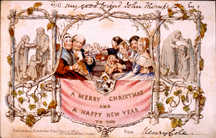Christmas has become associated with a whole range of traditions, some of them fairly ancient, and others of more recent vintage. One of these is the sending of Christmas cards, an international custom which keeps the world’s postal services fully occupied for the entire month of December. The manufacture of Christmas cards is now a multi-million dollar industry, and the myriad cards which are churned out with their cheerful, religious or sometimes maudlin themes have become so much part of the season, it is difficult to imagine that their origins do not actually go back very far.

As it is we know exactly when the first Christmas card was sent and by whom, and who designed it. There are some examples from the first batch of 1,000 which have survived, and which not surprisingly are regarded as collector’s items.
It seems that in the early decades of the nineteenth century, the English (or some of them, at least) were in the habit of giving their friends personal handwritten greetings. It was in 1843 that a businessman named Sir Henry Cole decided either he did not have time for that, or he would prefer something more artistic (he had interests in art and culture generally) and commissioned some printed cards to send to his friends.
He first retained artist John Horsley, a member of the Royal Academy to design his card. The designer produced a three-part creation, with the hungry being fed on one side, the poorly dressed being clothed on the other, and a happy bunch of well-fed Victorians drinking wine in the middle accompanied by the inscription ‘merry Christmas and a happy New Year to you.’ In the foreground is a child being offered a sip of wine – hardly politically correct nowadays.
It so happens that the central theme of the corpulent middle classes imbibing wasn’t regarded as politically correct in 1843 either, since the campaigners against alcohol promptly seized on the card’s immoral and unsuitable subject matter, as they saw it.
Their objections to this particular design, however, had no effect whatever on the Christmas card industry, which first in England and then in Germany, took off with a vengeance.
As said above, there were one thousand of these commercially printed cards sold that first year at a cost of one shilling each, and twelve months later the number had risen to 25,000. The advent of the Christmas card of course, came at a propitious time: the first penny post had been introduced, which meant that no matter what the destination, the card would cost no more than one penny to send – a sum well within the reach of the working classes. Secondly, Britain was becoming a lattice-work of train lines, causing a revolution in communication; and lastly, there had been various improvements in printing, which allowed for large numbers of cards to be turned out quickly on quite modest equipment.
While Germany caught on to the commercial Christmas card habit very fast, it took the United States somewhat longer. America imported English cards until 1875, when a German named Louis Prang began to manufacture them in Boston.
While popular at first, he was not able to retain the market because his designs, while attractive, were not Christmasy; they were of flowers and the like. Nowadays, of course, the world’s largest Christmas card manufacturers are American.
